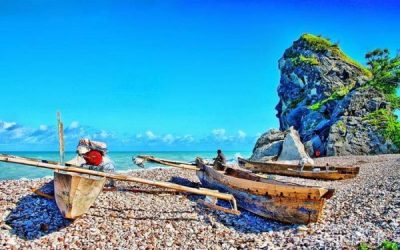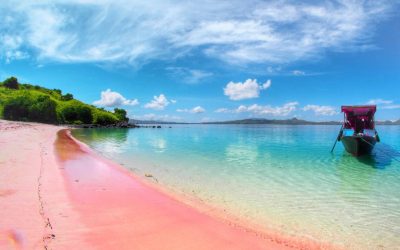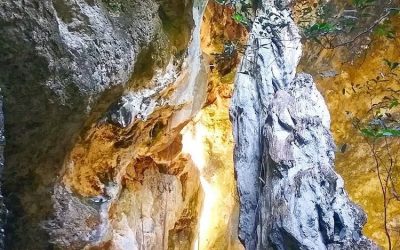Home / Batik Regions – Eastern Indonesia – East Nusa Tenggara / Komodo National Park – UNESCO World Heritage Site
Natural Destination
Komodo National Park – UNESCO World Heritage Site
Komodo National Park (photo: @Mardhana Ksatrya/Kompasiana)
Komodo National Park – UNESCO World Heritage Sites
Komodo National Park is located in Komodo Island, which is situated near the main port Labuan Bajo, East Nusa Tenggara. It was inscribed as UNESCO World Heritage Site in 1991 due to the presence of the world’s protected Komodo dragon. This park has some major attractions: lush reefs, manta point, pink beach and Komodo dragons park. Komodo dragons are carnivorous reptiles whose saliva is poisonous for humans. Watch out for the presence of those big lizards and pay thorough attention to the direction provided by the local guides when you are at Komodo site. Another stunning tourist attraction is Padar island, which is located next to Komodo Island. By taking the boat from Komodo island and hiking for 20-30 minutes to the top of Padar island, you will see an outstanding view of the island, along with its 3 colour beaches: white, pink and black. In addition, this region offers a great mixture of natural and cultural attractions with good tourism facilities as well. Do you want to experience earth’s extraordinary natural wonder? Visit Komodo Islands, Indonesia!
Natural Tourism Destination
Komodo National Park at Labuan Bajo Region
Tourist Attractions in East Nusa Tenggara
Kolbano Beach
Kolbano beach is one of Indonesia’s unique beaches whose sands consist of
Pantai Merah Muda – Pink Beach
Have you ever been to a beach were the sand is pink?
Batu Cermin Cave in Labuan Bajo
This place was once an underwater cave. It is named after the light that shines through
East Nusa Tenggara
Batik Motifs
Teguh Bersatu
This batik motif shows the strength of the people of Kupang. It also represents a sense of
Kuda Kupang
Horses symbolize wealth. It contains noble values of virtuous characters that bring
Discover
Indonesian
Batik
Motifs
Sero Tangga
The Sero Tangga illustrates an endearing feeling and sacrifices of a person to fulfil
Tabir Tanjung
Tanjung flower is a type of Cherry tree flower, which is commonly found in
Besurek Rafflesia
The term “Basurek” refers to a textile that contains letters or inscriptions
Gurdo Solo
Gurdo or garuda bird is the mount of the Indian god Vishnu. As the Sun Bird,
Dayak Taghol
Dayak Taghol has a distinctive style of four curved lines and small dots. This motif represents
Bekantan Pakis
This motif represents Pakis Haji (Polystichum setiferum), an endemic plant in
Besurek Rembulan
This batik illustrates praise for God who created the wonderful universe
Rumah Mamuju
the Batik motif illustrates the house of Mamuju King with the stairs, located on the left of the wooden stage house
Salakanagara
Salakanagara batik motif illustrates the first kingdom in the Betawi land
Merak Ngeram
The hatching peacock motif has a very deep meaning which refers to the sacrifice and
Malinau Cultural Festival
You will witness a unique competition that might not be found other than in
Kuda Kupang
Horses symbolize wealth. It contains noble values of virtuous characters that bring
Insang Ikan
Insang refers to the gills of the fish. This is a typical pattern of Malay ethnic who inhabits
Sandeq
Sandeq Boat is a symbol of the maritime importance of the West Sulawesi region. The greatness of
Manguni Minahasa
Manguni is identified as the symbol of the Minahasa people. Manguni is known as a
Bale Lumbu
This motif signifies the welfare of the ancient Sasak society. Bale also symbolizes the
Tangerang Herang
Tangerang Herang motif is a symbol of Tangerang city. The Tangerang Herang batik motif consists of
Tikar Natuna
The Tikar Natuna motif is adapted from the traditional making of pandanus mats in
Pucuk Rebung Riau
Pucuk Rebung symbolizes heart determination in achieving goals, good luck, and
Gamolan
This motif illustrates Gamolan, a bamboo musical instrument of Lampung that is
Wirasat
Wirasat or divine inspiration is a gift from God. This inspiration is symbolized by
Sekar Jati
Sekar means flower and Jati refers to teak trees that symbolizes a strong mental character that
Kaharingan
The Kaharingan or ‘tree of life’ based on the Dayak tribes’ belief system. This tree symbolizes
Gumin Tambun
Based on Hindu mythology, this motif symbolizes lucks, abundant wealth, and
Parang Rusak
Another meaning behind this motif is an unconquerable spirit, symbolized by
Raja Ampat
Raja Ampat motif represents the marine life at Raja Ampat archipelago in
Kain Cual
Cual textile tradition has existed since the 17th century. The word “Cual” refers to
Tongkonan
Toraja’s traditional house is called Tongkonan. Tongkonan is a place for
Bintik Tujuh
The Bintik Tujuh (Seven Dots) motif has 7 white spots and green color gradation as
Dayak Kamang
Kamang motif is generally found in the Dayak tribe shield because it is believed to
Daun Simpor
This motif is inspired by the Simpor plant (Dillenia Suffruticosa) which is a typical
Karawo Mahkuta
Mahkuta refers to Gorontalo’s traditional crown. It represents noble characters of
Angsa Duo
According to legend, the Angso duo batik motif is a pair of swans that are believed to have led Princess
Tampuk Manggis Sasirangan
The motif illustrates the philosophy of the mangosteen fruit, which is
Pati-Pati Pinehiku
It symbolizes the hierarchy in society and the social status of the Mekongga
Tenun Bima
The motifs are adopted from Bima woven textile. This pattern has received a great
Ukir Sentani
The Ukir motif is a batik motif that is inspired by various traditional Sentani wood carvings
Desa Na Tolu
The Desa Na Tolu characteristic pattern symbolizes the Batak philosophy of existence and
Tanah Liek
The word “Tanah Liek” refers to clay in Minang language. It is also known as
Taiganja
Taiganja is a precious gold pendant that shows the social status of the Kaili family. It is
Leuit Sijimat
This motif reflects the daily activities of the Baduy tribe in Banten. The main ornaments of batik motif consist of:
Gorga Simeol-Meol
The Gorga Simeol-meol is a pattern of plant tendrils. it is regarded as a symbol of longevity and
Tengkawang Ampiek
With its many advantages, the Dayaks use this leaf in ritual ceremonies. This plant is a symbol of
Cengkeh
The clove flower motif is the main commodity of the Tolitoli Regency. This motif represents
Buketan Bali
The Balinese bouquet (Buketan Bali) is a floral arrangement and the name is
Hiu Taliyasan
Indonesia is also home to the world’s largest fish, the whale shark (Rhincodon typus). Hiu Taliyasan refers to
Tifa Totobuang
The batik motifs illustrate Maluku’s traditional music instrument called
Kawung
The Kawung motif was created by Sultan Agung Hanyokrokusumo (1593 – 1645) as a symbolic gift for
Lipaq Sabe
Lipaq Saqbe contains a simple geometric classical motif with various flower decorations. This textile is
Lontara
The Lontara script itself is a typical ancient script of Bugis and Makassar communities. History records that
Sido Mulyo
Sidomulyo is one of the classical motifs, which is specifically used for the bride’s costume in
Honai
The Honai is inspired by the traditional house of the Papuan community living in
Gedhog Kembang Waluh
a combination of Javanese cultural motif of the Majapahit kingdom (XII-XIV century) with
Srimanganti
The name of the Srimanganti motif is derived from Palace’s hallway that connects to
Ake Patra
Ake is related to the divinity and the composition of the universe. It is a symbol of
Ikan tambal
The word “Ikan” refers to fish. The philosophical meaning of Ikan Tambal means is
Daun Sirih
This motif illustrates betel leaves that are used by Lombok communities as traditional
Gonggong Siput
Gonggong (Strombus Turturella) is one type of sea snail found around
Biji Kopi
The coffee seeds motif illustrates the pride of local coffee specialities in
Gajah Way Kambas
The motif illustrates the Lampung’s natural reserve, the Way Kambas. it also symbolizes
Wakatobi
It symbolizes the coastal beauty of the Wakatobi island and the symbol of Patra symbolizes
Paqbarre Allo
The word “Barre” means round and “Allo” means the sunlight. This motif is interpreted as
Parang Seling
Parang Seling or “alternating daggers” is a royal batik motif. It is a feminine variant of
Gigi Haruan Lidi
The Gigi Haruan Lidi motif is taken from the name of the cork fish and is a symbol of
Pattimura
Pattimura is the name of an Indonesian hero who fought against colonialism in
La Galigo
La Galigo is a literary work of the Buginese Epic that has 300 thousand epic lines. It is considered even
Enggang Dayak
Local people beliefs that hornbills are an incarnation of the Commander of the Birds. It has supernatural
Bultiya
The word ‘Bultiya’ is an acronym of the three major tribes in North Kalimantan, namely
Prada Papua
The word “Prada” in the Javanese-Indonesian dialect means a batik textile that
Rangkiang
The word “Rangkiang” refers to the rice granary in the Minangkabau language. It symbolizes
Singayaksa
The Singayaksa motif comes from the name of a place where Sultan Hasanuddin used to
Jumputan Bintang
The word Jumputan means the tie-dye technique, while the word “Bintang” refers to
Lok Baintan Floating Market
As you can imagine, the most authentic thing is that you can buy things and even
Awan Berarak
Awan Berarak is a combination of Dayak motifs and Malay patterns. The word ‘Awan Berarak’ means the




